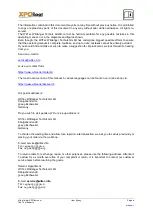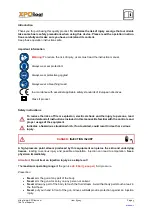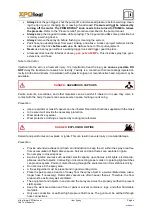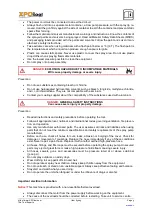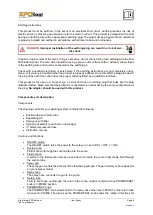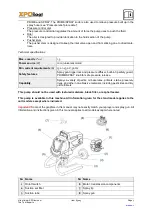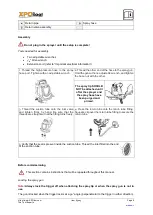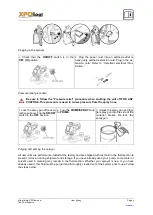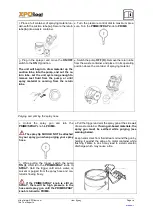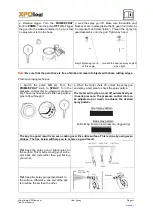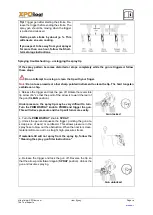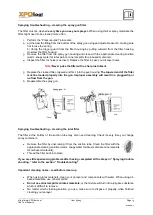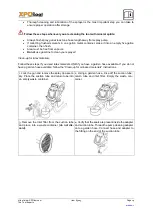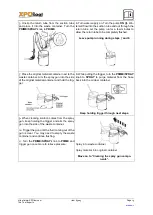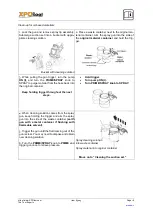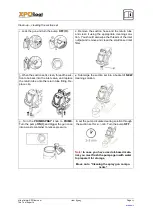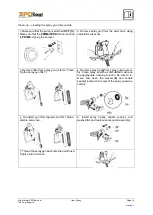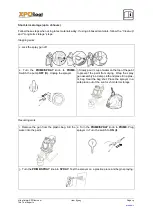
https://www.XPOtool.com
Item 63003
Page 4
The Tool Experts
01 2022
-1
•
Always
lock the gun trigger, shut the pump off, and release all pressure before servicing, clean-
ing the tip or guard, changing tip, or leaving it unattended.
Pressure will not be released by
turning off the motor. The PRIME/SPRAY knob needs to be turned to PRIME to relieve
the pressure.
Refer to the “Pressure relief” procedure described in the pump manual.
•
Always
keep the tip guard in place while spraying. The tip guard provides some protection but
is mainly a warning device.
•
Always
remove the spray tip before flushing or cleaning the system.
•
Paint hose can develop leaks from wear, kinking, and abuse. A leak can inject material into the
skin. Inspect the hose
before each use.
Do
not
use hose to lift or pull equipment.
•
Never
use a spray gun without a working trigger lock and trigger guard in place.
•
All accessories must be rated at or above
3,000
psi/20.68
MPa
.
This includes spray tips, guns,
extensions, and hose.
Note to the doctor
Injection into the skin is a traumatic injury. It is important to treat the injury
as soon as possible.
DO
NOT
delay the treatment to research on toxicity. Toxicity is a concern with some coatings injected di-
rectly into the blood stream. Consultation with a plastic surgeon or reconstructive hand surgeon may be
advisable.
DANGER:
HAZARDOUS VAPOURS
Paints, solvents, insecticides, and other materials can be harmful if inhaled or in case they come in
contact with the body. Vapours can cause severe nausea, fainting or poisoning.
Prevention
•
Use a respirator or mask if vapours can be inhaled. Read all instructions supplied with the mask
•
to be sure it will provide the necessary protection.
•
Wear protective eyewear.
•
Wear protective clothing as required by coating manufacturer.
DANGER:
EXPLOSION OR FIRE
Solvent and paint fumes can explode or ignite. This can result in severe injury or material damage.
Prevention
•
Provide extensive exhaust and fresh air introduction to keep the air within the spray area free
from accumulation of flammable vapours. Solvent and paint fumes can explode or ignite.
•
Do not spray in closed spaces.
•
Avoid all ignition sources such as static electric sparks, open flames, pilot lights, electrical ap-
pliances, and hot objects. Connecting or disconnecting power cords or operating light switches
can produce sparks. Paint or solvent flowing through the equipment can form static electricity.
•
Do not smoke in the spray area.
•
A fire extinguisher must be present and in good working order.
•
Place the paint pump at least 20
ft away from the spray object in a well-ventilated area (use a
longer hose if necessary). Flammable vapours are often heavier than air. Therefore, the floor
area must be extremely well ventilated.
•
The equipment and objects in and around the spray area must be properly earthed to prevent
static sparks.
•
Keep the work area clean and free of paint or solvent containers, rags, and other flammable
materials.
•
Only use conductive or earthed high pressure fluid hoses. The gun must be earthed through
hose connections.


